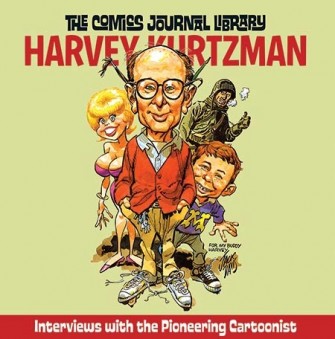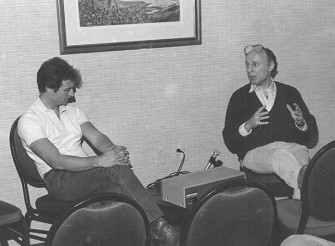 Home > CR Interviews
Home > CR Interviews A Short Interview With Greg Sadowski and Gary Groth
posted December 16, 2006
A Short Interview With Greg Sadowski and Gary Groth
posted December 16, 2006

 TOM SPURGEON: What led you guys to making Harvey Kurtzman the focus of his own issue? Was it just the amount of material available?
TOM SPURGEON: What led you guys to making Harvey Kurtzman the focus of his own issue? Was it just the amount of material available?
GARY GROTH: The Journal Library collections are essentially editorially configured in two formats: (a) solo artists who get their own book and (b) an ensemble of artists who are aesthetically or thematically harmonious who share a book. We've done both:
Jack Kirby,
R. Crumb, and now
Kurtzman, for example, getting solo books, and our collection of political cartoonists/illustrators
Jules Feiffer, Ralph Steadman, Edward Sorel, and David Levine cohabiting a single volume.
The solo artist volumes are never based on the amount of material available. Of course, there has to be enough material to constitute a book, but the editorial criterion is the aesthetic value of the artist. In my view, Kurtzman was one of the greatest cartoonists to have worked in the second half of the 20th century and deserved the space and cope a solo book could afford him.
SPURGEON: Are you a fan of his work and were you familiar with his career going in? Is there anything interesting about your past relationship to his work -- did you know him, did you collect his work, was he a favorite?
GREG SADOWSKI: Gary knew Kurtzman pretty well, but I never met him. I discovered
EC Comics when I was in high school in the mid-'70s. I would go to the
Phil Seuling comic conventions in Manhattan each month, and if I was lucky I'd find an EC or two in a condition I could afford. In time I amassed a modest but respectable collection. I was attracted to the
Al Feldstein titles at first, but soon realized that considerably more thought and care went into Kurtzman's books. I guess it's now the general consensus that Kurtzman's three EC titles (
Two-Fisted Tales,
Frontline Combat, and
Mad) comprise the finest run of comic books produced during the medium's first 50 years.
GROTH: As I mentioned in the book, I got to know Harvey pretty well when I administered a traveling cartooning salon that was the brainstorm of
Gil Kane called "The Master Class" that toured comic book conventions in the early '80s. It consisted of Harvey, Gil, and
Burne Hogarth, each teaching a class in their respective specialty (color application, storytelling, and anatomy). I booked the classes, signed up the students, and traveled with the boys, so I'd have many lunches and dinners with Harvey.

At this time,
Fantagraphics was in Stamford, Connecticut and Harvey lived in Mt. Vernon, New York, which were about a half an hour apart, so I would visit Harvey at his place or meet him for dinner, and occasionally get together with him and Gil, who complemented each other quite well in conversation. Harvey was somewhat past his prime at this point, warm and generous but also a little bitter and resigned.
SPURGEON: What materials did you work with on the book? Did you have to go outside the Fantagraphics library and if so, to whom and for what? I love the details of archival work, so please be as specific as possible.
SADOWSKI: I did find plenty of stuff in the Fanta library and files, and I had many of the comics in my own collection. Glenn Bray had graciously allowed us access to practically his entire collection of Kurtzman originals. Unfortunately, after I had placed most of them in the layout I was informed that all of the unpublished pieces and most of those under copyright by the Kurtzman estate were off limits. It seems the estate is planning its own deluxe coffee table Kurtzman book (which I can't wait to see). So out they went. That was the low point for me on the project. Suddenly I had to scramble around, trying to figure out what I could use that hasn't already been seen a hundred times.
Thankfully, two angels came to my rescue: Al Jaffee and E.B. Boatner. A few years ago I had tagged along with John Benson while he paid a visit to Jaffee's Manhattan studio. The highlight of the visit was when Jaffee pulled out a series of drawings from a 1972 assignment he had done during Kurtzman's tenure as Esquire cartoon editor. After Jaffee had submitted his initial drawing to Kurtzman, the editor created a series of roughs outlining his own detailed conception. (Normally, these roughs would have been trashed after the job was completed, but Jaffee loved them and held on to them.) I remembered those drawings and phoned Al, who was kind enough to let us use the best of them. To me, that particular feature anchors the entire book, because it's unadulterated evidence of the amount of pure hard work Kurtzman poured into every assignment.
I became aware of E.B. Boatner's work from the Kurtzman photos in Russ Cochran's EC Library. After establishing contact with the photographer I was soon sent a veritable treasure of unpublished slides. (By the way, a book of Boatner photos is in the works.) With Boatner and Jaffee on board I was now confident we had enough solid unseen material.
SPURGEON: Did you have Denis Kitchen's help or the help of the family?
GROTH: Not only did Denis Kitchen not help us put together the book, but he impeded its production to the extent he could.
SPURGEON: Talk to me specifically about unearthing the solo freelance career material.
SADOWSKI: Most of my unearthing was accomplished simply by opening Glenn Bray's Harvey Kurtzman Index. Practically everything Kurtzman ever published is listed there. Not only that, Glenn owns copies of most of it and was more than happy to make it available. He really made my job a breeze in that respect. Other Kurtzman aficionados (Ger Apeldoorn, John Benson, Sean Burns, Sean Conlon, and Jim Vadeboncoeur) filled in the blanks.
SPURGEON: Can you talk about your approach to designing the interiors of a book like this? How much of a factor does illustrating what's being talked about play? How do you select what imagery to use, or decide how much imagery to include?
SADOWSKI: Any designer's first responsibility in a book of interviews is to illustrate what's being discussed. Otherwise you only piss off the reader. You have to try to provide as illuminating an experience as you can pull off.
SPURGEON: The publicity for the volume talks about every stage of Kurtzman's career being represented. Are there aspects of Kurtzman's career that you think have been under-appreciated, and if so, in what way might this book serve as a corrective?
SADOWSKI: I think the freelance work is under-appreciated because most of it hasn't been seen for over 50 years, such as Kurtzman's Mad-like assignments for the collegiate magazine Varsity. We show a nice sampling of that. Then there's Kurtzman's post-
Mad work for
Esquire,
Madison Avenue,
TV Guide, and
Pageant, which I think is terrific, and is also given its due here.
Poring over Bray's Index, however, I realized that Kurtzman didn't do a heck of a lot of solo freelance work. He simply wasn't a popular artist in his day. His style was too idiosyncratic for commercial success, which was why he was forced to cipher his drawings and layouts through artists such as Jack Davis and Will Elder, and why he hung so tightly to the security of his collaboration with Elder on
Little Annie Fanny. From painful past experience, he understood that he could never make it on his own as an artist. He comes right out and says that at some point in the interviews, and you feel for the guy. Even though he knew deep-down he was a great artist ("With pictures I'm second to no man!") he was resigned to the fact that his best chance of success was to function as writer/editor/layout-man. But this book clearly shows that Kurtzman was an amazing artist in his own right.
SPURGEON: Do you have a favorite amongst the interviews being re- published, and if so, which one?
SADOWSKI: I actually enjoyed them all. John Benson's 1965 conversation is great since he caught Harvey while he was still actively editing and at the top of his game. The mammoth one conducted by Kim and Gary in 1981 is remarkable for its scope and depth. But I found even the more casual chats fascinating. Choice insights and opinions are revealed when things become relaxed and informal.
SPURGEON: What do you think Kurtzman's legacy is today, and how might that change 20 years from now? How is his influence felt?
SADOWSKI: Well, of course,
Mad's influence on popular culture -- let alone comics -- is so obvious that it hardly needs mentioning. Kurtzman is so pervasive a figure that just about anyone doing non-super-hero work -- even if they've never heard of him -- can't help but be a part of his legacy, at least to some degree. What really struck me from these interviews was the incredible amount of effort he put into his work -- how rigorously he approached a medium that paid him peanuts. Any editor/cartoonist/writer who busts his ass to do worthwhile work can't help but follow in Kurtzman's footsteps.
GROTH: Kurtzman's legacy may have trickled down as far as it can at this point; no one reading his
Mad-edited issues now can be as affected by it as artists like R. Crumb and Gilbert Shelton were when they read it as kids in the '50s. His cultural legacy may give way to his aesthetic legacy, that is, what may affect young artists now is his cartooning, by which I mean specifically the absolute, unerring beauty of his line and the expressiveness of his drawing.
Like most of the truly great artists who started out and worked in mainstream comics -- Kirby is the perfect example -- Kurtzman was never "pure" in the sense that his writing and drawing came together satisfactorily. As he said himself, he was not as good a writer as he was an artist and in the best cartoonists these two skills are roughly equal and virtually indistinguishable -- the reader can't quite tell where one stops and the other begins. Kurtzman probably came closest to this ideal in
The Jungle Book -- and, of course, he had what may be the most perfect collaborator in the history of comics with Will Elder -- but I think his legacy will ultimately reside in his drawing.
Finally, I'd just like to praise Greg, who took all the source text material, unearthed a treasure trove of visual material to complement it, and did a magnificent job of putting it all together.
*****
*****
The Comics Journal Library Vol. 7: Harvey Kurtzman, Greg Sadowski, Fantagraphics, Paperback, 124 pages, $19.95, December 2006, 1560977558 (ISBN)


